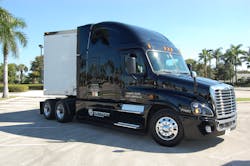One of the more perplexing issues uncovered in the 26th annual State of Logistics (SOL) report – issued by the Council of Supply Chain Management Professionals (CSCMP) and presented by Penske Logistics – centers around the lack of upward movement in trucking freight rates, despite a growing lack of truck capacity across all segments of the industry – from drayage and LTL to TL.
“I absolutely cannot understand why trucking companies are not in the driver’s seat regarding freight rates, and I’ve been saying this for the last two or three years,” Rosalyn Wilson, senior business analyst with Parsons Corp. and author of the annual SOL report, told Fleet Owner by phone.
The trucking data collected and analyzed by Wilson indicated some pricing increases occurred last year and into the first quarter of the 2015, but not at all to the level expected in light of the high level of truck utilization.
This year’s SOL report – presented as part of logistics panel discussion held at the National Press Club in Washington, D.C. – found that trucking, which is the largest component of U.S. transportation cost, jumped 3% in 2014, with the intercity truck segment posting a 2.7% uptick and the local delivery segment increasing 3.7%.
While the number of truck freight shipments declined overall in 2014, truck tonnage increased 3.5% – supporting “anecdotal evidence” in Wilson’s words that “loads are heavier and more trucks are moving at or near full capacity.”
Yet she stressed that total freight payments in 2014 increased less than the increase in the number of shipments, indicating that rates remained flat and competitive overall.
For example, Wilson noted that on a cost per ton-mile basis, trucking costs increased 2.5%, yet on an average cost-per-mile basis, costs actually dropped 2.1% drop in 2014.
She noted, too, that this issue is affecting all segments of the trucking industry – even drayage operations at major ports.
“The underlying problem at the ports was, and still is, primarily supply issues,” Wilson explained in the SOL report. “Trucks, especially drayage trucks, were in short supply as the profitability of that segment of the truck sector continued to decline.”
She added that one major problem is that today’s larger twenty-foot equivalent unit (TEU) ocean container ships deliver far cargo in a condensed time frame and there is not enough equipment available to handle the surge.
“The new containerships can be up to one-third larger than Los Angeles and Long Beach ports have the capacity to handle,” Wilson pointed out. “Consequently, drayage carriers reported that they made fewer turns because of the congestion, eating into their profitability. Truckers reported waiting hours in line to pick up a container only to find that there was no chassis available. That makes the day a total loss for the driver because he or she is not paid by the hour but rather by the mile.” Yet, while the economics of supply and demand looked like they might come back into play as chassis, trucks, and drivers became scarce commodities, rates did not rise in the segment.
That’s one reason why Joe Carlier, senior VP of sales with Penske Logistics, noted that there doesn’t seem to be a “clear reason” why this contradiction between almost 100% capacity utilization and what he called “steady rates” exists in trucking.
“That’s the big question because it isn’t making sense,” he said in an interview with Fleet Owner prior to the SOL report’s release. “That’s what has really popped out of this year’s report as unique; what is really behind this ‘flat rate’ trend.”
About the Author
Sean Kilcarr
Editor in Chief
Sean Kilcarr is a former longtime FleetOwner senior editor who wrote for the publication from 2000 to 2018. He served as editor-in-chief from 2017 to 2018.
